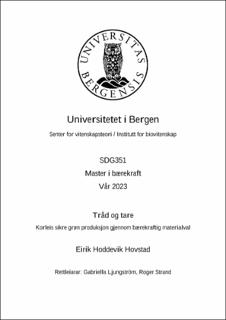Tråd og tare. Korleis sikre grøn produksjon gjennom bærekraftig materialval
Master thesis
Permanent lenke
https://hdl.handle.net/11250/3070656Utgivelsesdato
2023-05-15Metadata
Vis full innførselSamlinger
Sammendrag
Abstract: This master's thesis presents the findings of my internship at Ocean Forest, a large-scale producer of kelp, with the objective of improving and enhancing the efficiency and sustainability of their production. The company previously used thin plastic ropes in the seedling production, which resulted in the emission of microplastics into the environment. The thin seedling ropes are twined around a bigger harvest rope, but the ropes are one-time use. Since they are one time use, they cause significant time consumption of cleaning after the harvest. Ocean Forest are in the process of transitioning to alternative production materials, and presented a question that I have worked on this past year: what is the optimal rope to use in the farming of sugar kelp (Saccharina latissima)? To address this question, the thesis is structured around three separate questions: 1) Are there are differences in the growth of sugar kelp gametophytes on thin ropes of different materials? 2) What are the optimal dimensions for a thin rope to naturally degrade in time for harvesting? 3) Is one thin rope material more sustainable than another? The research conducted revealed that cotton is the best growth medium for sugar kelp, while wood fibers performed poorly. Nonetheless, wood fibers possess greater strength and do not degrade as fast as cotton. Wood is also more sustainability than cotton, utilizing less energy, freshwater, and chemicals in the production process. Therefore, the answer to the inquiry is that a cotton thread is recommended, but with the condition that the cotton is sustainably farmed.
